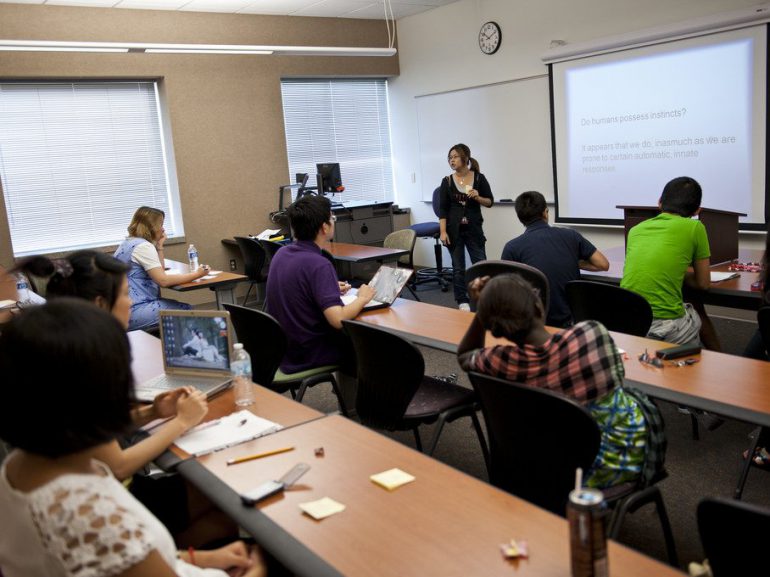With the beginning of semester 1 looming, many higher degree research candidates will be preparing to tutor for the first time. This is likely to be both exciting and anxiety provoking. Seasoned professors and undergraduate students alike can never be quite sure of what to expect from a given tutorial group, but as tutors we assume responsibility for creating teaching spaces that are intellectually engaging, socially inclusive, and pleasurable. Like all professions, developing the skills for effective teaching in tutorials takes time, involves productive failures, and requires ongoing reflection. But for those new to the task, a number of considerations can stand you in good stead.
Understand your material, but also your role as tutor
Your students will expect you to have a good grasp of the course material, but not that you’re a genius nor the world expert in the field. Your experience in your discipline and at university will be valuable here, and the means by which you will guide students to different debates, theorists or answers. But not knowing the answer can be OK too. As Ruth Barcan notes, ‘feelings of fraudulence’ are common in contemporary universities, and structurally underpinned by the common experience of teaching on courses or in fields outside our developing expertise. Rejecting the inclination to bluff a response, and instead noting ‘I’m not sure about that, but perhaps we can work it out together’, can also convey important lessons about knowledge and learning themselves: that knowledge is partial and cumulative and that it can be learned collectively. The tutor’s role is to facilitate the student’s learning in relation to the unit material, and this is importantly different from the value of lecturers and unit coordinators’ other responsibilities. The tutorial is our students’ main opportunity to learn by doing – through discussion, group tasks, and collective analysis – and it’s the tutor’s role to establish the environment in which this can occur.
Know your students
Your unit of study will be part of a larger programme, which you may or may not have taken as an undergraduate student. Discuss with your unit coordinator how the course relates to the other parts of that programme. Cohorts at various degree stages have different broad needs. For example, first year students may require an emphasis on pastoral care, and information on how the institution works including about various student services, while senior students may demand more refined intellectual engagement with the discipline or advice on postgraduate study and job options. We should nevertheless be careful not to generalise students’ needs based on the unit of study itself. Depending on the discipline, students will enrol in a course as part of a linear degree trajectory, or as an intermediate level unit that complements others in that major. Students may be local or international, full-time, part-time or on exchange, first in their family or the children of academics, and may be enrolled as a degree requirement or simply to fulfil a personal interest. Taking time to learn about the familiarity of your students with the discipline, what they know from other study and elsewhere, and their motivations for being there will make you a more effective teacher. This will help you to scaffold difficult material, and to address different levels of expertise and forms of life experience simultaneously. Providing opportunities for students to convey other personal information that they would prefer you are aware of – e.g., learning difficulties, social anxiety, preferred pronouns, etc. – will also support their participation. Acknowledging such forms of diversity in the classroom is important on behalf of fostering academic and inter-personal generosity among a cohort. It can establish confidence among students new to the field based on what they already know, provide a challenge to experienced students to test their thinking through collaborative discussion, and promote an ethic of care and an understanding of the limits of knowledge derived from experience that is differentiated by axes of social identity. These are also valuable classroom lessons.
Understand the unit of study trajectory
Speak to the unit coordinator and former tutors of your course about its logics and rhythms. Schedule early on when you will need to complete your marking. And know in advance how a concept, debate or reading in week 2 will be centrally relevant to the focus of week 6, for example. Provide regular, albeit brief, commentary on how the content learned in past weeks is relevant to the present week’s material, and subsequent assessments. Establish a clear understanding of assessment due dates and requirements, including the timelines that students should be implementing in order to meet those deadlines successfully. Your students will generally want to know what is required of them for an assessment task, and how best to prepare for that, more so than the details of what theorist X said about object Y. Make sure to provide time in each tutorial where students are able to ask questions regarding assessments. And beyond your own unit, be conscious of the broader rhythms of the university semester. Students are less likely to have completed required reading or tasks in weeks where major assessments are due, which are similar across units and thus contribute to student over-work, pressure, and stress at certain times. Acknowledge your awareness of this to students and anticipate tutorials that will require some of this preparatory work to be undertaken together, remembering that tutorials should be fun as well as intellectually engaging.
Prepare a tutorial plan
Everyone has a different approach to preparing for tutorials. Certain activities are obvious requirements: attend the lecture; read the unit of study guide; complete the readings; familiarise yourself with other unit resources; and reflect on approaches taken in your other tutorials. The ultimate objective is to be able to walk into the room feeling secure in your understanding of the unit content, confident that you can support students’ understanding of that content, and with some idea of what’s likely to happen in the tutorial. My own tutorial notes are often highly detailed lists of questions, organised by topics, and framed by generic activities to structure their consideration (e.g. close textual analysis, task-based group work, general discussion, etc.). But such documents are usually poor representations of what actually happens in the tutorial. A discussion that I’d anticipated would last fifteen minutes might be insightfully completed in five, requiring a plan B, or students might provide perspectives and examples that are more effective for engaging with the unit content than those I’d planned to discuss. Establishing a broad set of tutorial learning objectives should allow you to be flexible with the ways these are met. Your tutorial plan – whether typed up detailed notes or a memorised set of central points – is thus a safety net rather than a list of obligations.
Prepare yourself
There are easier ways to earn money than university tutoring. It can provide pleasures and rewards that are often absent from our more atomistic research activities, but it can also be time-consuming, stressful, and intellectually challenging. As a first-time tutor, familiarise yourself with your employment contract, including whether this takes account of activities such as attendance at tutor training workshops, lecture attendance, team meetings, and student consultations, as well as administrative work and the pay formula for marking. It’s common for first time tutors to devote significant amounts of time to marking and pastoral care. While some people might frame this in a broader trajectory of academic skills development, and certainly our efficiency in such matters improves over time, it can be useful to remember that you are also an employee: you are only employed for so many hours. And so too that your responsibilities are circumscribed: you are not a counsellor, housing officer, or proof reader; you can instead support students in accessing such university services.
Preparing yourself to tutor for the first time might also involve some reflection on your experience in university classrooms as a student. Who were the tutors that you rated highly? What was it about their practice that was effective in facilitating your learning? Or, even, were there tutors that you definitely want to avoid emulating? Such assessments might depend on those individuals’ personal attributes, disciplinary knowledge, pedagogical approaches, or techniques in the classroom. Developing an academic identity is never so straightforward as emulating one individual, but such reflection can help establish particular orientations for your teaching practice. It should also be informed by the acknowledgement above of student diversity, which includes a variety in preferences for learning styles and techniques.
Finally, tutoring for the first time will always be helped through discussion with your colleagues, whether fellow first-time tutors or experienced professors. We learn as much about teaching through gossip and anecdote as we do through formal training modules. Avoid the possibility of taking colleagues’ horror stories as typical, but try to learn from their experiences of common tutoring challenges: transforming the quiet class; managing the dominating student; constraining administrative work; teaching in and with silence; not knowing the answer; and responding to students’ personal problems. The more you know about others’ approaches to tutoring, including the diversity of effective approaches, the more confident and effective you’re likely to be.
This post was contributed by Liam Grealy from the Department of Gender and Cultural Studies at The University of Sydney.





